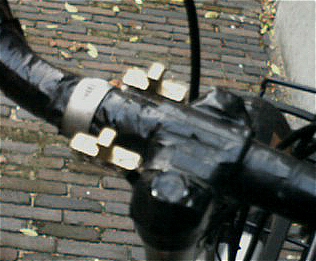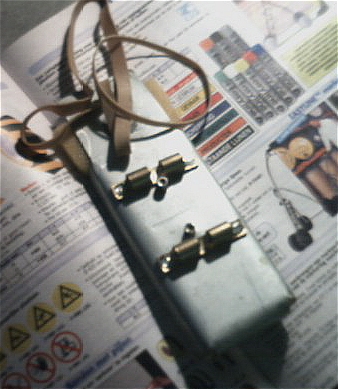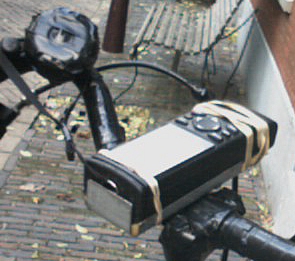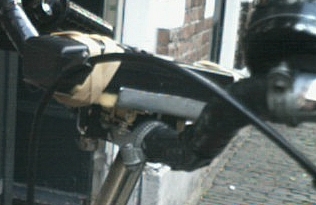Because of the ruggedness and intended use I have bought a Garmin GPS 12 in the summer of 2001 and use it for geocaching in the Netherlands.
For transportation I use a typical Dutch transport vehicle: a bicycle with a small 29 cc 2-stroke grassmower-type petrol engine built halfway into the back wheel. These bicycles are locally known as 'snorfiets' or by the brand name 'Spartamet' and have a legal maximum velocity of 25 km/h or about 7 m/s according to my GPS.
There is a Dutch language group about the Spartamet with Yahoo groups.
More about my adventures with this machine can be found here (in Dutch) (click to 'verhalen').
Measurement with the legal bindings off give me a max. velocity of 32.4 km/h (without wind, not very often) All shock-absorption is done by the pneumatics of the tyres and for the user a double-action shock-absorbing saddle is needed. Even then - while bumping along countryroads - I am in fear losing my teeth!
So how to use a GPS in such an extreme environment?
Two rubber bands fasten the GPS to a metal plate, the same size as the GPS, cussioned by a thin layer of foam. The metal plate clicks on the handle-bar near the centre (less swinging-vibration).
Here is a picture that gives a better view and shows that I do not trust totally my DIY construction and use the wrist-wrap for extra security.

The GPS has functioned (for 360 hours now) without problems.
On the first day of use I found out that the batteries (GP NIMH 1600 mAh for nearly 12 hours of continued use) did move so much in the casing that no safe electrical connection could be maintained for long. My solution was: do a wrap-around with tape so that they fit snuggly - without lateral movement - in the battery compartment. But not too much tape: they have to slide out time and time again!

Here is a good view of the vehicle of Prof. Y. Lupardi using two cylindrical transportation facilitation devices (patent pending). The small engine is nearly invisible. And be astonished about the saddle!
In the summer of 2005 I constructed a new carrier for my GPS12.
I started with a piece of heatingpipe 22 mm and cut that open lenghtwise. Folding it open I made two sidewings on the tube. A part of these I sawed off to make the use of a gardenhoseclamp possible.
On the wings I screwed two parts (the male ones) from two closetlockers.

On the groundplane where the GPS12 is attached to I put the female parts. To make sure there is no shifting possible lenghtwise there are two retaining screws.

How it looks like when in use: see these photographs:









